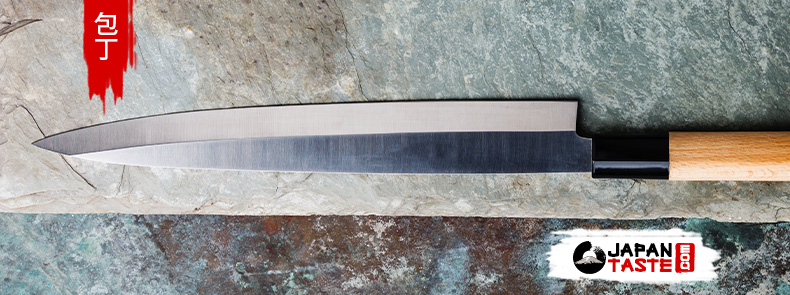Japanese knives are essential and indispensable utensils for Japanese cooking. The quality and taste of your sashimi and other Japanese dishes will depend on your cutting and the quality of your knife. It is better to use Japanese knives with specific functions. Presentation :
- The Japanese kitchen knife
- The different types of Japanese knives
- The Yanagiba knife
- The deba knife 出刃
- The usuba knife 薄刃
- The santoku knife 三徳包丁
- Our tips for maintaining your Japanese knife :
The Japanese kitchen knife
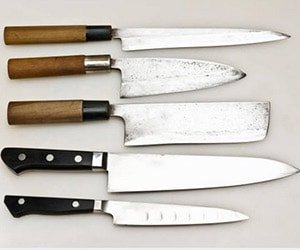 The origins and quality of Japanese knives come from the manufacturing of the famous Japanese swords, the katana. The best knives are made of steel forged according to the method called “honyaki“, it is a material with a high carbon content. Each craftsman has his own technique to design the best knives, some can reach thousands of euros, but don’t worry, there are more affordable ones. Count on about 100 ~ 150 € for a good value knife. The Sakai region, located south of Osaka, is the cradle of quality Japanese cutlery production. You will also find very good shops in Kyoto. If you want to have a lot of choices, don’t hesitate to go to Tokyo in the street kappabashi which is a famous shopping avenue for Japanese cutlery
The origins and quality of Japanese knives come from the manufacturing of the famous Japanese swords, the katana. The best knives are made of steel forged according to the method called “honyaki“, it is a material with a high carbon content. Each craftsman has his own technique to design the best knives, some can reach thousands of euros, but don’t worry, there are more affordable ones. Count on about 100 ~ 150 € for a good value knife. The Sakai region, located south of Osaka, is the cradle of quality Japanese cutlery production. You will also find very good shops in Kyoto. If you want to have a lot of choices, don’t hesitate to go to Tokyo in the street kappabashi which is a famous shopping avenue for Japanese cutlery 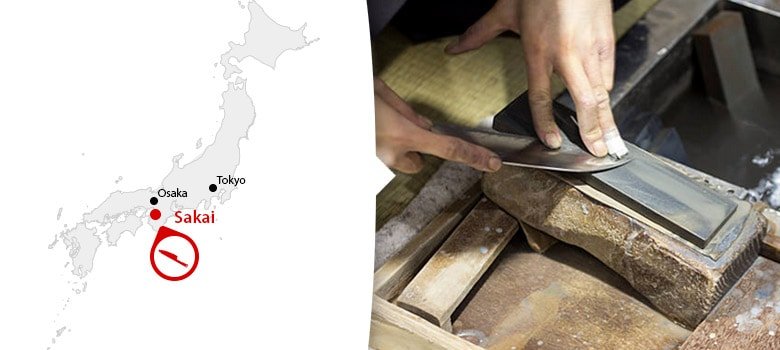 The art of cutting is an integral part of the training of a Japanese cook, the knife must be of very high quality and the technique mastered. In general, the training of a Japanese cook is 10 years.
The art of cutting is an integral part of the training of a Japanese cook, the knife must be of very high quality and the technique mastered. In general, the training of a Japanese cook is 10 years.
We are impressed by the blades of Japanese knives. By touching a leaf, it splits in 2 without forcing, you can make tomato slices as thin as cigarette paper… Moreover, the wooden handle is very comfortable and pleasant to use.
The different types of Japanese knives
The Yanagiba knife
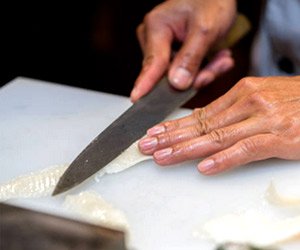 It is a thin and long knife which allows to cut sashimi in one stroke. Its blade is very long, professionals use blades up to 30 cm, but you can be satisfied with a 21 cm.
It is a thin and long knife which allows to cut sashimi in one stroke. Its blade is very long, professionals use blades up to 30 cm, but you can be satisfied with a 21 cm.
The deba knife 出刃
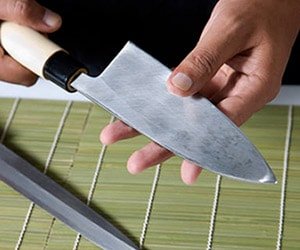 The deba is a wider and thicker knife than the yanagiba. It is used to lift fish fillets and cut them into small pieces like tataki. Its blade is rather short but varies according to the size of the fish.
The deba is a wider and thicker knife than the yanagiba. It is used to lift fish fillets and cut them into small pieces like tataki. Its blade is rather short but varies according to the size of the fish.
The usuba knife 薄刃
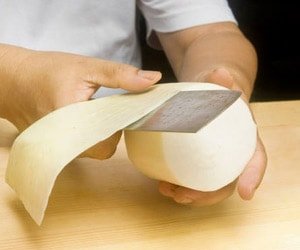 It is mainly used for chopping and cutting vegetables exclusively. Its blade is thin, wide and rectangular. The usuba is a lighter knife than other knives.
It is mainly used for chopping and cutting vegetables exclusively. Its blade is thin, wide and rectangular. The usuba is a lighter knife than other knives.
The santoku knife 三徳包丁
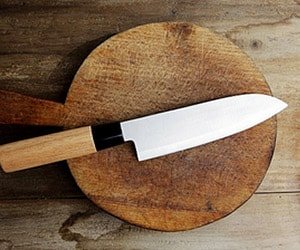 The santoku knife is a versatile knife, it can cut vegetables as well as meat or fish. We advise you to buy this one first if you hesitate between the 4 because this knife can be used every day.
The santoku knife is a versatile knife, it can cut vegetables as well as meat or fish. We advise you to buy this one first if you hesitate between the 4 because this knife can be used every day.
There are many knives, some of them are specifically designed for cutting one kind of fish or for cutting octopus, eel, soba
(buckwheat noodles), noodles, meat, bones…

Our advice to maintain your Japanese knife:
- Use a sharp knife, sharpen it with a stone at least once a week. Then rinse your knife well and dry it well. To know if your knife is sharp, slide the blade on one of your nails. If the blade slides, the knife deserves to be sharpened, conversely, if the blade does not move, then it is not necessary to do so.
- Keep a clean, damp sponge towel available to wipe the knife blade after each use, for example after cutting a slice of fish.
- Beware of counterfeit knives, you will often find knives called “santoku” that do not come from Japan and are not really santoku. Prefer the 100 % made in Japan, because you will have a knife guaranteed with a quality steel!


